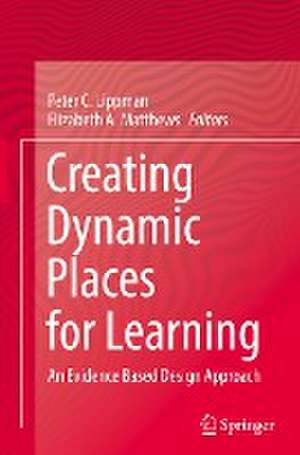Creating Dynamic Places for Learning: An Evidence Based Design Approach
Editat de Peter C. Lippman, Elizabeth A. Matthewsen Limba Engleză Hardback – 22 aug 2023
This book showcases how an evidence-based design approach can be utilized in the planning of learning environments, by acknowledging the interconnectedness of research, practice, and theory as core considerations in the design of learning environments. Toward this end, this volume explores a multi-disciplinary perspective that draws upon modern learning theories, and empirical research from the fields of environmental psychology education, and architectural practice. By presenting this information in an accessible manner, it enables researchers, educators and designers to take actionable steps needed to re-imagine their settings and create dynamic places for learning.
Preț: 895.58 lei
Preț vechi: 1092.17 lei
-18% Nou
Puncte Express: 1343
Preț estimativ în valută:
171.39€ • 175.52$ • 142.57£
171.39€ • 175.52$ • 142.57£
Carte tipărită la comandă
Livrare economică 19 martie-02 aprilie
Preluare comenzi: 021 569.72.76
Specificații
ISBN-13: 9789811987489
ISBN-10: 9811987483
Ilustrații: VIII, 273 p. 75 illus., 62 illus. in color.
Dimensiuni: 155 x 235 mm
Greutate: 0.58 kg
Ediția:1st ed. 2023
Editura: Springer Nature Singapore
Colecția Springer
Locul publicării:Singapore, Singapore
ISBN-10: 9811987483
Ilustrații: VIII, 273 p. 75 illus., 62 illus. in color.
Dimensiuni: 155 x 235 mm
Greutate: 0.58 kg
Ediția:1st ed. 2023
Editura: Springer Nature Singapore
Colecția Springer
Locul publicării:Singapore, Singapore
Cuprins
Introduction.- Part 1: Visioning process.- School designs for personalising and co-constructing the learning journey.- Working in non-western cultures: A framework for functional school design.- Pedagogy matters: Cultivating independent learning in college classrooms.- Part 2: Research in context.- The school security environment and adolescents’ feelings of safety and academic performance.- Making the transition from teacher-centred teaching to students’ active learning: developing transformative agency.- Out of the box: Lessons from the Covid-19 school lockdowns for future learning environments.- Virtual learning in university settings is not a new modality. Though old and new challenges continue to arise in recent years?- Part 3: Design.- Creating dynamic school buildings that activate the learner and the learning process.- Affordance theory as a framework for 21st century learning principles.- An ecological approach for creating dynamic learning environments.- Not buying into the hype of contemporary or new school learning spaces: One school’s attempt at interrogating their “actual” impact on teaching and learning.- Conclusion.
Notă biografică
Peter C. Lippman, M. Phil, M. Psych., BArch, Associate AIA, has been researching, writing, and designing activity-based learning environments that engage teachers and learners. His work is grounded in his academic research and action research projects, where social science methodologies are used to guide the programming, planning, and design of learning environments. Fueled by his desire to understand how and why teachers and learners operationalize the different settings in the learning environment, he creates places that are responsive to their needs. He is an acknowledged Thought Leader in the field of educational architecture and a prolific writer. Peter not only presents his research at conferences internationally, but most importantly, works with educators throughout the world to re-imagine their environment to positively impact learning, learners and the things to be learned.
Elizabeth A. Matthews is Assistant Professor of Psychology and Education in the Division of Interdisciplinary Arts & Sciences at City College, CUNY. Her research interests center on the physical environment of children and youth, school security and violence, and the impacts of physical space on mental health in young people. She has conducted both quantitative and qualitative research on the physical elements of school security and hosted conferences that have brought an international group of researchers, policy-makers, and educators to dialogue on the key issues impacting school design.
Textul de pe ultima copertă
This book showcases how an evidence-based design approach can be utilized in the planning of learning environments, by acknowledging the interconnectedness of research, practice, and theory as core considerations in the design of learning environments. Toward this end, this volume explores a multi-disciplinary perspective that draws upon modern learning theories, and empirical research from the fields of environmental psychology education, and architectural practice. By presenting this information in an accessible manner, it enables researchers, educators and designers to take actionable steps needed to re-imagine their settings and create dynamic places for learning.
Caracteristici
Examines contemporary learning theories and educational research as relates to culture and context
Showcases evaluation as means to guide the practice of teaching from a contextual perspective
Provides tangible solutions for creating dynamic places for learning
Showcases evaluation as means to guide the practice of teaching from a contextual perspective
Provides tangible solutions for creating dynamic places for learning
